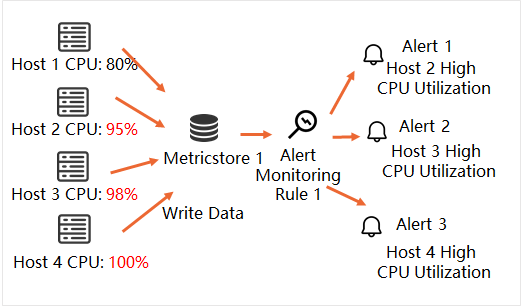When you create an alert monitoring rule, you can configure the Group Evaluation parameter. When the alert monitoring system processes query and analysis results, the system can group the results based on specified fields. The results in each group are evaluated based on a specified trigger condition. If the results in a group meet the trigger condition, an alert is triggered. You can use an alert monitoring rule to monitor multiple groups of query and analysis results at the same time. You can manage alerts and incidents for each group.
After you configure the group evaluation feature, the maximum number of groups in which query and analysis results can be evaluated at a time is 100. If the number of groups in which query and analysis results are evaluated is greater than 100, only 100 of the groups are selected at random and sent to the alert policy.
When you select fields for group evaluation, we recommend that you select a field that can identify a monitored entity and whose values can be enumerated. If a field cannot identify a monitored entity, we recommend that you do not select the field. If you do not select a suitable field, an excessive number of groups are generated. If the trigger condition in a group is met, an alert is triggered. If a large number of groups exist, alert storms may occur. In this case, you may miss out on important alert information.
For example, you can select fields such as the host and method fields in NGINX logs and the bucket field in Object Storage Service (OSS) access logs. Do not select fields such as the request_time and body_size fields in NGINX logs or the err_cnt field in error logs.
Example 1: Monitor time series data by group
In this example, the metric data of multiple servers is stored in a Metricstore. Requirement: If the CPU utilization that is specified by cpu_util of each server exceeds 95%, an alert is triggered, and Simple Log Service sends an alert notification for each server. To meet this requirement, you can configure the group evaluation feature when you create an alert monitoring rule. 
You can configure the following parameters:
Query Statistics: Specify
* | select promql_query_range('cpu_util') from metrics limit 1000.This query statement is used to query the CPU utilization of each server.
Group Evaluation: Select Auto Tag.
This value specifies that the query and analysis results of time series data are automatically grouped.
Trigger Condition: Select data matches the expression, enter value > 95, and then select Severity: High.
If a value of the value field in the query and analysis results is greater than 95, an alert whose severity is High is triggered.
Add Annotation: Specify annotations such as the title and description of an alert. You can reference field variables such as ${host} in an annotation. For more information, see Add labels and annotations.

Example 2: Monitor logs by group
In this example, OSS access logs are monitored. Requirement: If the number of times that the HTTP status code 500 is returned for each bucket per minute exceeds 1,000, an alert is triggered, and Simple Log Service sends an alert notification for each bucket. To meet this requirement, you can configure the group evaluation feature when you create an alert monitoring rule.
You can configure the following parameters:
Query Statistics: Specify
http_status=500 | select bucket,count(1) as pv group by bucket having pv > 1000 order by pv desc.This query statement is used to query the buckets for which the number of times that the HTTP status code 500 is returned exceeds 1,000.
Group Evaluation: Select Custom Tag and bucket.
The values specify that the query and analysis results are grouped by bucket.
Trigger Condition:
Condition 1: Select data matches the expression, enter pv > 3000, and then select Severity: High.
If a value of the pv field in the query and analysis results is greater than 3000, an alert whose severity is High is triggered.
Condition 2: Select Data is returned and select Severity: Medium.
If data is returned in the query and analysis results, an alert whose severity is Medium is triggered.
Add Annotation: Specify annotations such as the title and description of an alert. You can reference field variables such as ${pv} in an annotation. For more information, see Add labels and annotations.
